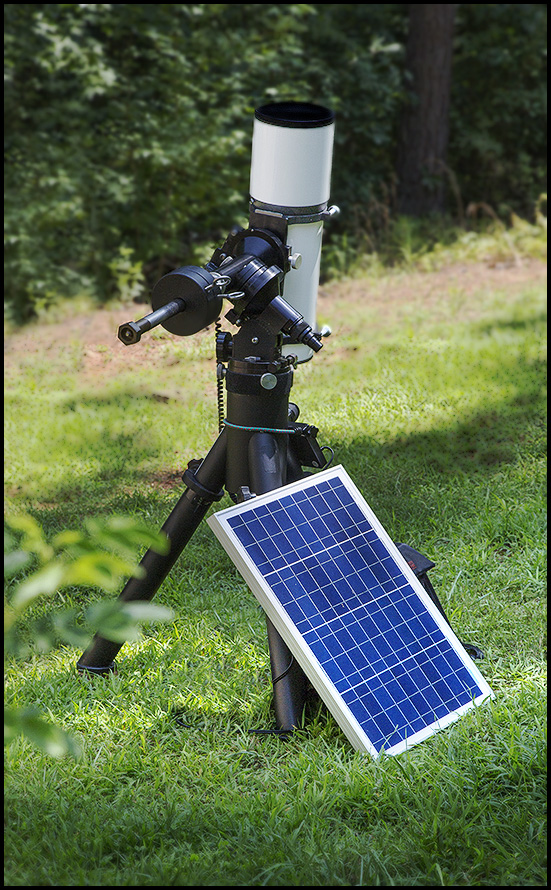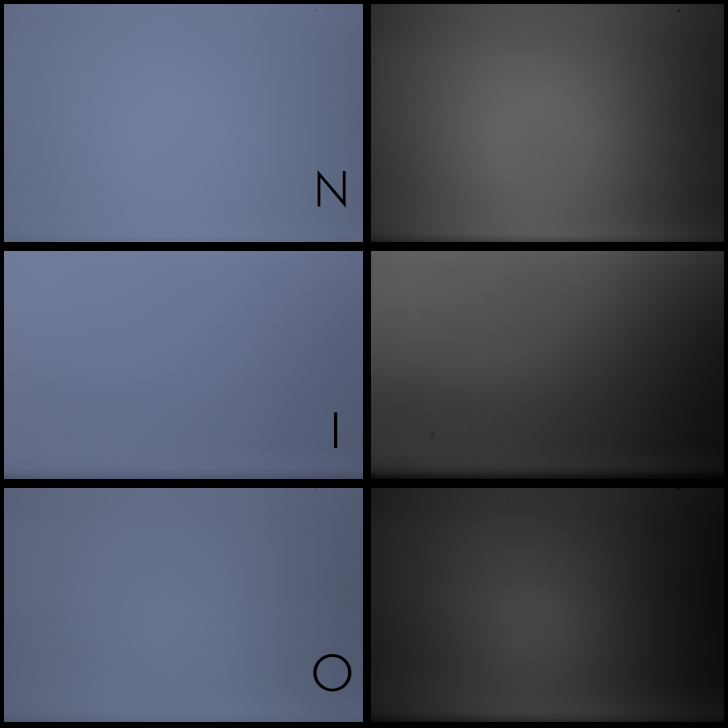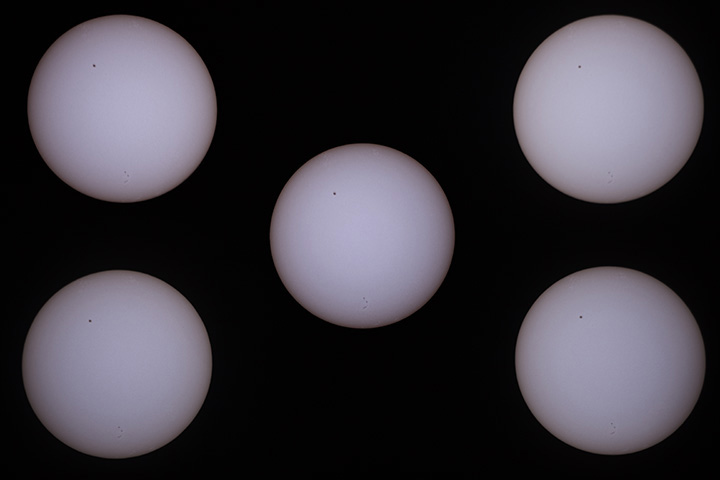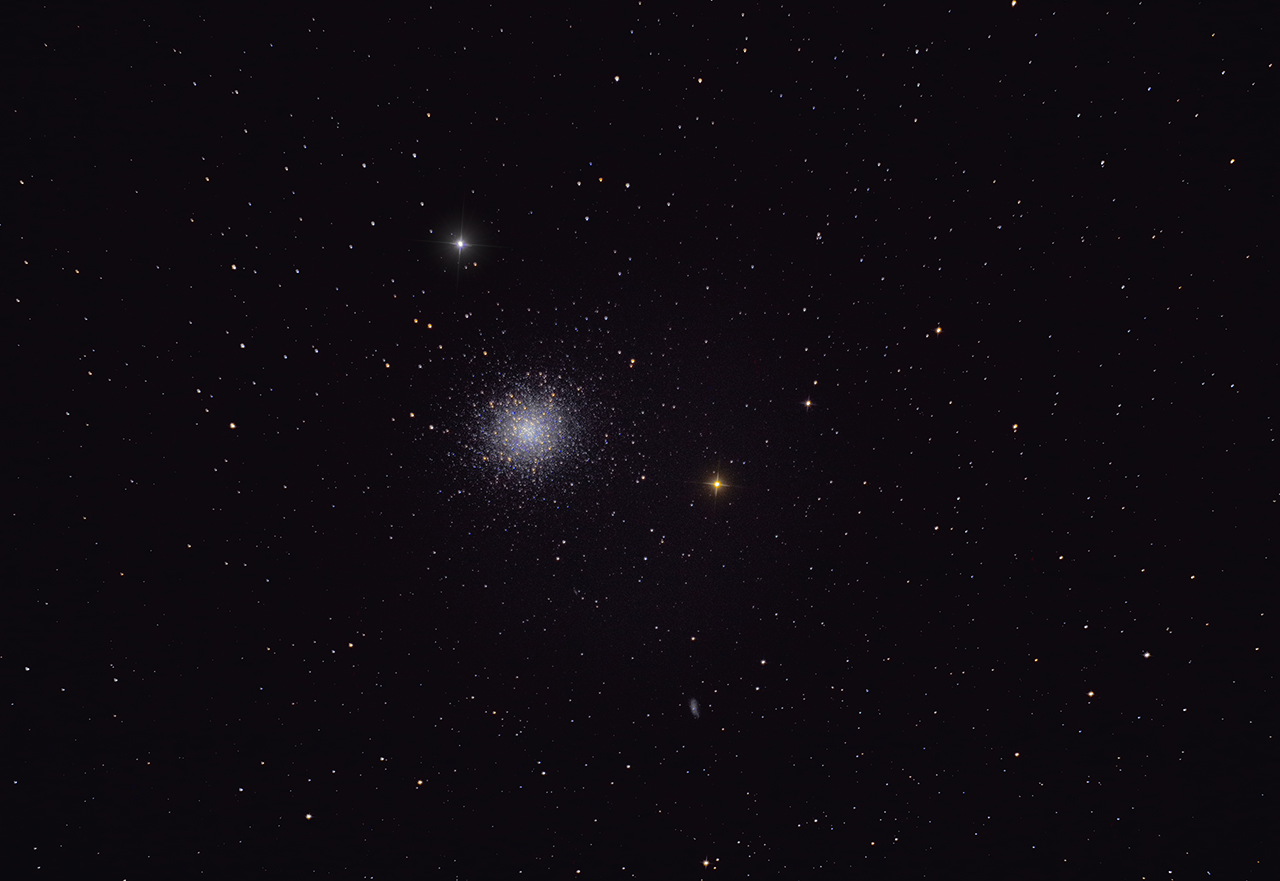
A good start on an eternal battery for stargazing while boondocked.
7/30/2014. Mobile observatory notes.
-
I've cut down a set of travelling legs for the G11 (24-inches each).
-
Adjusted the Losmandy pier top to fit my G11 mount (holes were 1/16" or so too low to align with the G11 head; I sanded the end of the piertop with #80 grit and an orbital sander to make them closer).
-
Marked the north leg of the piertop for easiest assembly.
-
Adopted a 12V 18AH Kendrick battery pack from AstroMart to drive the G11. (12-hour tracking rundown trial: 12.5 - 12.0V measured under load; Vega nailed in the center of a 1-degree field for the last hour of the trial; 12.46 unloaded V; check polarities and supplement/charging capabilities next; see below.)
-
Set up a 50w Renogy solar panel and charge controller (Amazon) to keep the observing battery topped off; work this out and then expand the solar kit to keep the RV's house battery charged, too. Thinking hard about how this should work.
-
Bench-tested an SBIG STV autoguider (Astromart) to eliminate the need for computer control; open question: OAG or guide 'scope?
Star trials will come in the backyard when I can again see stars (summer haze...).
A used 10-inch F3.9 Orion reflector will likely become the main glass. Because it's already been butchered more or less to my liking, I'm not intimidated by cutting, drilling, repainting and generally messing with it, and I have lots of ideas for optimizing it as the RV-based astrograph. If that works out, then the 6-inch is the just-looking 'scope as originally intended. Several pro's and few con's come to mind when considering a Newtonian for the RV's main optics; I'll rehearse them when it's in hand and I can do so without jinxing the whole damn thing. Until then, the refractor is the big glass.
I've registered Topaz "Clean" and "ReMask" plugins -- the former is for aggressive noise and "surface" control and the latter for cutouts without green screens. ReMask works well (see photo above). Clean appears to be just the ticket for noise in deep sky images: it seems to make quick work of much of the more aggressive noise-suppression techniques illustrated in Gendler's (ed.), Lessons from the Masters. A couple of casual trials were promising enough to justify licensing the software while it's on sale.
7/30/2014. I attached the 50w solar panel to the Kendrick powerpack (via the Renogy charge controller) at 11:30 this morning and left it to replenish the battery until about 6:00 this afternoon. The sky was mostly clear with periods of high clouds and brief interludes of mostly overcast -- a lot of sunlight. The battery came up some (12.6 unloaded; ~12.3 with the G11 running; up from 11.95 under load this A.M.), so it's not all the way back, but juice is surely flowing.
I shot some blue sky "flats" with the 6D to check the illumination of its full-frame sensor behind the 6-inch achromat. I'm very pleased -- and surprised. I was using a short, wide-mouth 2-inch adapter:

6D behind 6" F5.9 refractor.
N: Nominal infinity focus (approximate)
I: focuser full in (2" extender in place)
O: focuser full out (2" extender and GSO diagonal)
Full-range on left; severe histogram stretch to the right.
Inverting these and converting to monochrome then multiplying each frame by its inverse produced really nice, even frames. That's Photoshop's version of applying a flatfield. We'll see how well this works on faint deep-sky targets where the histogram stretches can be brutal, but so far, so good. Unflatted, light appears to fall off on the order of 20-30% in the corners.
The Newtonian astrograph is here. Practice cleaning up the RV came in handy:
-
I removed two NASA decals, assorted bits of Velcro, and a couple of OEM stickers. Heat gun, then whatever solvent worked. As usual, different layers of glue and goop responded better to different cleaners. Very clean looking tube now.
-
I drilled two holes in its mounting rings adjacent the threaded ones so I could use 1/4x20 socket head bolts to attach the rings to the threaded "safety" holes in a venerable, much-drilled Losmandy D-plate. I also made rudimentary risers to take up about 1/4 inch of excess bolt length (replacing the bolts with shorter ones will therefore lower the CG incrementally).
-
The focuser is marginal, but I have ideas for
re-engineering it. It only has to reach one point, after all: where the 6D wants to be. Surely I can manage a few mm of adjustability around that point without going the full Moonlite / FeatherTouch route. Some aspects of the stock focuser are impressive (there are collimation adjustments and an easy release feature to remove most of the hardware without messing with the tube-mounting bolts), but as supplied it was missing a lock screw and could neither lift nor hold much weight. I expanded and tapped one hole to take a 1/4x20 bolt to serve as a lock. The focuser's action was very rough and "grindy." I disassembled it and lubed the wheels, track, and all the points where rotating parts bear against stationary ones. That made it quieter, but when I was done it was extremely weak. I rotated the moving tube so that the flat track does not bear against the Crayford axle(!). This made it much better, smoother and stronger, but I think a brass shim on the flat track will be a better solution. I attacked the tube with a dial caliper this morning and ordered a bit of 0.016" brass off eBay. [Too thick!]
Casual flats shot into a white diffuser in the basement with the camera at two extensions (one about halfway to max and the other near max, extension tubes and focuser position combined) are encouraging.

6D behind 10" F3.9 Newtonian.
Top: middle of extension, nominal focus.
Bottom: full extension.
Left, default histogram; right, stretched.
I went to the Agena Astro Products website for a Baader MPCC MkIII and EOS T-ring (not the fancy one that holds filters, maybe later) because I am 99% sure that efforts to get really good starfields would otherwise be doomed by coma: I'll be using a large sensor behind a very fast parabaloid. I'll decide about guiding options later; I'll probably use a 50-70mm finder/guider mounted to the tube rather than the heavier 80mm Short-tube mounted to the rings. Or something.
As for a mount, I think the G11 will work nicely. G11's have been used (with spotty success) to carry C14's, which are 40% heavier and have 4x longer FL's. Not only is this OTA lighter and of shorter EFL, but it's feeding a camera with an immense sensor. I've used this G11 to carry a refractor that weighs 75% as much with 75% of the focal length using a 3x smaller sensor, and it worked without breaking a sweat (infuriatingly at times, granted). I'll be astounded if I can't get round (enough) stars out of it.
[See below!]
Which gets at the crux of why a Newtonian: it doesn't stress the mount I have available for the traveling kit. Would I prefer a Mach1 and an R-C? You bet. But I'm not parking mine in the RV; I want it here. And I can't afford a second matching kit. (Besides, if I had what I want there'd be an A-P 1600 carrying a big ole Planewave or AstroTech -- 16-20 inches of fancy optics on state of the art machinery. Hell, as long as we're wishing, put a U16 CCD behind it and forget the RV. Put it and us on a nice quarter section in the Datil Mountains. But that's not happening either. Not soon anyway.) 10-inches of fast glass in front of a sensitive DSLR on a competent (but unspectacular) mount it is. Even fast Newtonians aren't as sensitive to mis-collimation as R-C's are, and when they are jarred out of alignment they are not too tough to put back in. Did I mention the buy-in cost? Just to be clear: a fast Newt is a fraction of the price of even a budget R-C, and a slightly messed up used one is even less. The mount is free; it's one I already own. Likewise several cellar-dwelling bits and pieces.
8/13/2014. The 10-inch F4 Newtonian is coming along. I reworked the focuser a couple of different ways. I'm not particularly happy with it, but it works well enough -- at least for a lightweight DSLR. Here's the first-light image: this is the Sun through Baader film, a composite of five exposures.

The Sun
1/4000s ISO 200, Canon 6D
Centered and in each corner
Baader MPCC MkIII Coma Corrector
The size of the solar image (1410 pixels) and the Sun's angular extent (31.58') tells me the telescope is working at F4 (F3.96 but who's counting except Orion who round it down to F3.9 to distinguish it from their competitors' likely identical optics). The 6D has a plate scale of 1.34 seconds of arc per pixel. It comes to focus with some room to spare, and the quick look at the Sun was very encouraging. The G11 does not feel, look, or act overloaded. First light under the stars will be telling. Maybe tonight! The first autumnal front is coming through.
Aha! Not that it's perfect, but much worked: the focuser handled the DSLR nicely, the G11 seems solid under the 10-inch, alignment was adequate unto the purpose (30s exposures). I used Maxim to combine 8 raw frames for luminance then the same 8 tiff conversions for color (got to be a better way, but this worked). Voila. "View image" for a 1280-pixel version:

M13, 10-inch F4 Newt on G11
8x30s ISO 3200, Canon 6D, MPCC-MkIII
4 minutes total. Unguided.
Right click for a larger view.
The extension tubes connecting the camera to the focuser seem less than ideal. A couple of times, I caught the stack tilting a bit. I have some alternatives well short of replacing the focuser with a Moonlite outfit. Now I'm going around and around about how to put a guide-scope alongside. Half a dozen schemes chase one another through my head. I like the 9x60 finder I've bolted to a top rail and will likely leave it where it is. I might mount it a little bit higher for easier vieiwing.
Fortunately, I get to play with collimation before becoming (more) obsessed with the guiding optics, mechanics, and electrics.